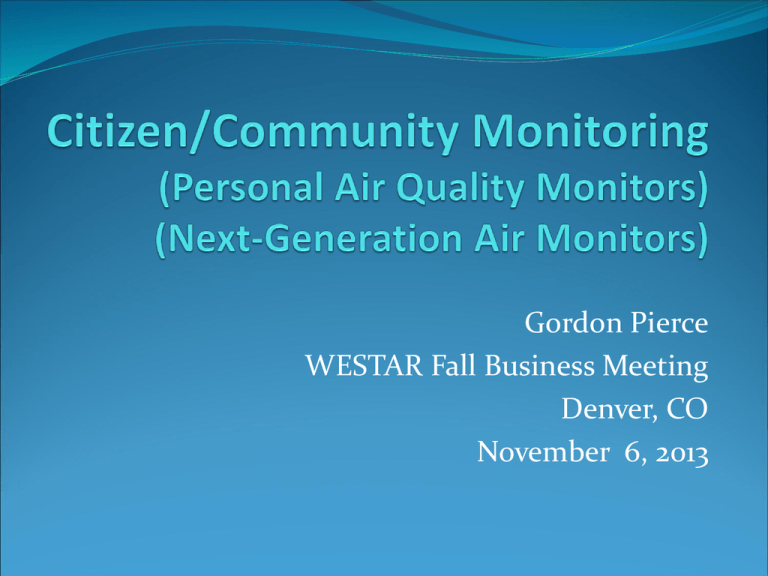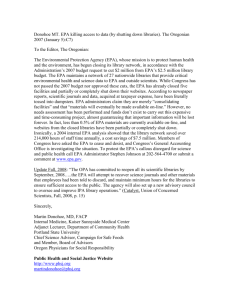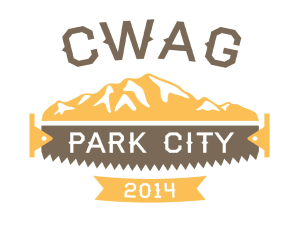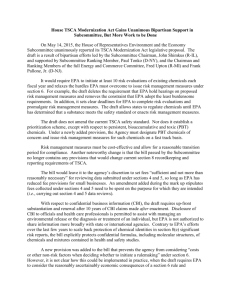Personal monitor presentation
advertisement

Gordon Pierce WESTAR Fall Business Meeting Denver, CO November 6, 2013 Problem Small, low-cost air monitors are becoming common and easy to obtain Anyone can monitor and post data to a website Quality of the data are unknown Hard for agencies to deal with after data are out EPA has held a series of “Air Sensors” workshops at RTP focused on next-generation air monitoring Most recent was in March 2013 2 Overview Low cost = less than $2000, many less than $1000 Small, easy to transport Some put out high quality data Data easy to upload Many samplers do not currently have adequate validation Communications are lacking O3, CO, CO2, NO2, PM and VOC are the most common applications being developed 3 What is being done? EPA has held a series of “Air Sensors” workshops at RTP focused on next-generation air monitoring Most recent was in March 2013 Goal is to get information to vendors on: What types of monitoring is needed? What are typical ambient levels of pollutants? What types of sensors are available? What validation/calibration is needed? What documentation is needed? Want to put the responsibility on manufacturers for their product 4 Data Quality Requirements EPA 5 Characteristics of Gas and PM Sensors White, Univ. of Calif. Berkeley 6 Future Next-generation samplers are here and their use will expand Will likely become a key component of health care EPA needs to get out in front Better communication with manufacturers, communities, regulators Clearinghouse is needed with toolbox Better health-risk data are needed Possibly restart the Environmental Technology Verification (ETV) program 7 EPA Draft Roadmap Intended to summarize major findings from literature reviews, workshops, and discussions with experts about Next Generation of Air Monitoring (NGAM), particularly sensor technologies. Developed to share EPAs early thinking about how best to support the successful development and use of new monitoring technologies Identifies key issues in need of EPA leadership and an ambitious set of priority objectives for EPA and other partners to address 8 Example: EPA Village Green Project Solar-powered air-monitoring system designed and incorporated into a park bench EPA began testing the system in the summer of 2013 Measures O3, particulates, meteorology Air pollution and weather data are automatically sent to the Village Green Project website http://villagegreen.epa.gov 9 Example: AirCasting Platform for recording, mapping, and sharing health and environmental data using your smartphone Connects to the AirCasting Android app over Bluetooth CO and NO2 sensors Plans and self-build for $200 www.habitatmap.org 10 Example: Air Quality Egg Egg-shaped base station receives the wirelessly transmitted data from the sensor box outside Relays that data to the Internet via a wired Ethernet connection CO and NO2 sensors Purchase for $185 www.airqualityegg.com 11 Example: M-Pod Developed by University of Colorado O3, NO2, CO, CO2, VOC, temperature, RH Data uploaded to mobile device and web Costs $300 12 Example: Dylos Laser Particle Counter with 2 size ranges Store up to 30 days of air quality history Costs $200 - $300 (depending on options) www.dylosproducts.com 13 Example: CitiSense Data wirelessly transmitted to the user’s smartphone Displayed on the smartphone via a custom app Display also utilizes the EPA’s color code scale O3, CO, NO2 14 Questions? 15











